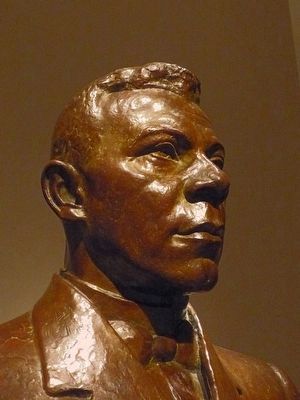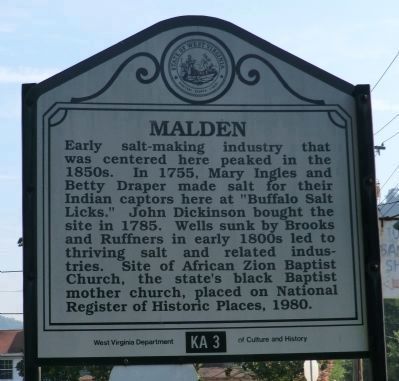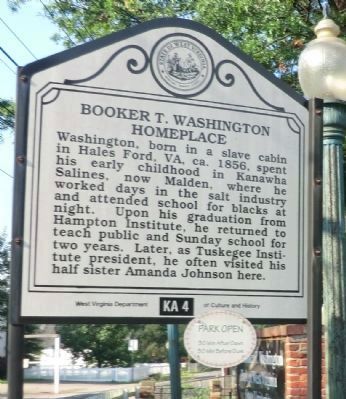Malden in Kanawha County, West Virginia — The American South (Appalachia)
Malden / Booker T. Washington Homeplace
Malden. Early salt-making industry that was centered here peaked in the 1850s. In 1755, Mary Ingles and Betty Draper made salt for their Indian captors here at "Buffalo Salt Licks." John Dickinson bought the site in 1785. Wells sunk by Brooks and Ruffners in early 1800s led to thriving salt and related industries. Site of African Zion Baptist Church, the state's black Baptist mother church, placed on National Register of Historic Places, 1980.
Booker T. Washington Homeplace. Washington, born in a slave cabin in Hales Ford, VA, ca. 1856, spent his early childhood in Kanawha Salines, now Malden, where he worked days in the salt industry and attended school for blacks at night. Upon his graduation from Hampton Institute, he returned to teach public and Sunday school for two years. Later, as Tuskegee Institute president, he often visited his half sister Amanda Johnson here.
Erected by West Virginia Department of Culture and History. (Marker Number KA 3/KA 4.)
Topics and series. This historical marker is listed in these topic lists: African Americans • Colonial Era • Education • Settlements & Settlers . In addition, it is included in the Historically Black Colleges and Universities, and the West Virginia Archives and History series lists. A significant historical year for this entry is 1755.
Location. This marker has been replaced by another marker nearby. It was located near 38° 17.931′ N, 81° 33.461′ W. Marker was in Malden, West Virginia, in Kanawha County. Marker was at the intersection of Malden Drive (County Route 60/6) and Cypress Drive on Malden Drive. Touch for map. Marker was at or near this postal address: 4200 Malden Drive, Charleston WV 25306, United States of America. Touch for directions.
Other nearby markers. At least 8 other markers are within 2 miles of this location, measured as the crow flies. Booker T. Washington (here, next to this marker); The Necessary Ingredient (here, next to this marker); Lewis Ruffner (here, next to this marker); a different marker also named Booker T. Washington (a few steps from this marker); African Zion Baptist Church (about 300 feet away, measured in a direct line); Rev. Ruffner's Grave (about 800 feet away); Ruffner Well (approx. ¼ mile away); Burning Spring Monument (approx. 2 miles away). Touch for a list and map of all markers in Malden.
Related marker. Click here for another marker that is related to this marker. This marker has been replaced with the linked marker.

Photographed By Allen C. Browne, August 9, 2015
3. Booker T. Washington
This 1973 bust of Booker T. Washington by Richmond Barthé sits in the National Portrait Gallery in Washington DC.
“In the face of racial hatred, segregation, and disenfranchisement following the Civil War, it was unrealistic, Booker T. Washington contended, to expect African Americans to gain entry into America's white-collar professions. Instead, he suggested they establish themselves as a skilled and indispensable laboring class. With that accomplished, racial discrimination would gradually disappear. In 1881 Washington put this theory to the test, becoming the director of the newly created Negro Normal School in Tuskegee, Alabama. As the school grew, Washington became viewed as the nation's leading spokesman for African Americans. Yet by the century's end, many critics began to challenge his ‘get along’ philosophy.’” — National Portrait Gallery
“In the face of racial hatred, segregation, and disenfranchisement following the Civil War, it was unrealistic, Booker T. Washington contended, to expect African Americans to gain entry into America's white-collar professions. Instead, he suggested they establish themselves as a skilled and indispensable laboring class. With that accomplished, racial discrimination would gradually disappear. In 1881 Washington put this theory to the test, becoming the director of the newly created Negro Normal School in Tuskegee, Alabama. As the school grew, Washington became viewed as the nation's leading spokesman for African Americans. Yet by the century's end, many critics began to challenge his ‘get along’ philosophy.’” — National Portrait Gallery
Credits. This page was last revised on August 5, 2021. It was originally submitted on September 4, 2014, by PaulwC3 of Northern, Virginia. This page has been viewed 577 times since then and 28 times this year. Photos: 1, 2. submitted on September 3, 2012, by Don Morfe of Baltimore, Maryland. 3. submitted on October 17, 2015, by Allen C. Browne of Silver Spring, Maryland. • Kevin W. was the editor who published this page.

